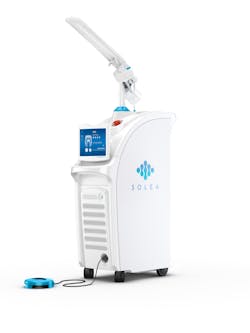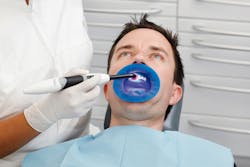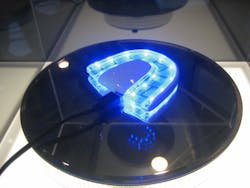A little girl's mouth gapes open as she hears the song "Let It Go" in Disney's blockbuster Frozen. At just that moment, her dentist applies laser light to a cavity—and the girl truly can 'let it go' because she doesn't feel a thing. In both fiction and fact, light-based dental tools are completely changing the world of dentistry: Blue-light technology from PhotOral (Lexington, MA), Bluephase Style from Ivoclar Vivadent (Schaan, Liechtenstein), and the Solea CO2 dental laser system from Convergent Dental (Natick, MA) are just a few examples.
Simplifying with CO2
Early in 2014, Convergent Dental brought its Solea CO2 dental laser system to the market. Convergent CEO Michael Cataldo says, "We developed it from scratch." A dentist can use this device for hard and soft tissues, such as teeth and gums, respectively. "It allows a dentist to perform all of the procedures that can be done with a drill, just as fast and without anesthesia," Cataldo says. With no need for anesthesia, this technology saves a dentist time. In addition, Solea cuts soft tissue with very little bleeding, which saves even more time—not to mention unwanted complications.
Beyond helping dentists, this device also makes life easier for patients who can get fillings without anesthesia injections, and without the noise and vibration of a drill. In fact, Cataldo confirms these claims from firsthand experience. As he says, "I was patient number one! I had a huge old filling removed, and I never felt anything."
This CO2 laser's 9.3 μm wavelength, says Cataldo, "is the key factor in the anesthesia-free, blood-free performance." He adds, "It's the first dental laser to incorporate computer controls of the beam." For example, a dentist can select the size of the beam pattern, which mimics using different burr sizes on a drill. The computer also determines the pulses per point, the time between points, how far the laser skips between points, and so on.
The biggest challenge in developing this device came from so many moving parts. For help with that, Cataldo and his colleagues worked with a number of firms, including Hernetics (Chelsea, MA). According to Hern Kim, principal designer at Hernetics, "We developed the overall industrial design of the Solea, from the ergonomics to the aesthetics." Convergent put a high priority on an easy transition for a dentist. Kim says, "It has a drill-like hand piece that all dentists are familiar with, easy-to-navigate touch screen, and an incredibly responsive variable-speed foot pedal." These features make a dentist feel comfortable from the beginning.
The tool also provided inside challenges. The designers had to design a package that was beautiful, functional, and small enough to work in a typical dental facility without disrupting the complex systems that keep 14 precision mirrors in alignment (see Fig. 1) while the dentist moves the hand piece and the laser pulses thousands of times per second, which Kim calls "unheard of in the industry."
Quicker curing
After removing decayed material in a tooth, a dentist must fill the void. The first light-cured composites came out in the 1960s, and curing lights followed. To cure the composite faster, the light must provide more energy. Not long ago, with a light that generated 400–500 mW/cm2, it took about 40 s to cure a 2 mm layer of composite. The curing takes less time, usually 10–20 s, with some of today's lights that create around 1000 mW/cm2. The Bluephase Style, which generates 1100 mW/cm2, cures dental composites in just 10 s (see Fig. 2).The Bluephase Style uses Polywave LED technology, which means that it uses more than one LED wavelength. Using blue and violet LED chips, this curing light covers the 400–500 nm range. "This is the only range of wavelengths that light-curing materials need," says Reinhard Goerge, head of the department of direct restoratives at Ivoclar Vivadent. "Using this range, you can be sure that all of the dental materials will be cured."
In addition to high power, Goerge and his colleagues wanted to make this device convenient for a dentist to use. So it's cordless. "This requires efficiency to use a lightweight battery that provides enough capacity to use the device for at least a day," Goerge says.
Beating the right bacteria
Hundreds of species of bacteria—as many as 700 in some instances—can be found on the surface of a single tooth, but only some of them cause gum disease. Furthermore, blue light of around 450 nm kills the detrimental bacteria. Consequently, Nikos Soukos, founding director of the applied molecular photomedicine laboratory at the Forsyth Institute (Cambridge, MA) and chief scientific officer at PhotOral, says, "Phototherapy could play a very important role to prevent or treat periodontal disease."
Although conventional thinking in dentistry suggests that all plaque—a biofilm of bacteria—should be removed, Soukos disagrees. "Some people have a huge amount of plaque and no disease," he says. Maybe healthy teeth come from the right balance of "good" and "bad" bacteria.
A commercial product in development by PhotOral would be used twice a day for a minute or two. It uses LEDs in a mouthpiece-like device (see Fig. 3). "You put it in your mouth and bite down," Soukos says. "Blue light targets the area between and the gum and the tooth, which is where dental plaque resides."Beyond destroying bad bacteria, the PhotOral device might help a patient's teeth and gums stay healthy. "There is preliminary evidence that the light may suppress dental plaque and enhance the immune system," Soukos says.
The PhotOral blue-light technology will not displace toothbrushes and floss, but it could improve tomorrow's teeth and gums. In fact, light-based technology promises to remodel tomorrow's dentistry. "In the next 10 years," says Cataldo, "the application of light in dentistry vs. tactile equipment, like the drill, will change everything."


